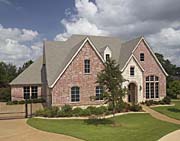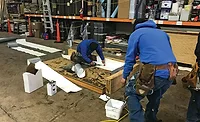Changing the Face of Roofing
Few developments have implications industry wide, but a new "cool roof" initiative may change how virtually any kind of roofing is made, at least on the surface. Researchers have fine-tuned the pigments and surfacing techniques for roofing materials that increase the membrane's solar reflectivity, reducing heat gains and thus saving energy. Preliminary test results indicate measurable energy savings for building owners with a minimal cost increase.
Several roofing manufacturers are so convinced about the science behind it that they have already introduced products, even before in-situ testing is completed. An unprecedented industry effort is underway to catalog the "cool" pigments, test the energy savings and get to market a ready-made, painless energy saving product.
"We've seen it coming and we wanted to be the first," says Mike McLintock, director of marketing, Elk Premium Building Products. The company just introduced the industry's first asphalt shingles in a choice of earth-toned colors with solar reflective granules. "We think this is a real good start."

Warming Up to It
As the world braces for perpetually high energy prices, the effort to reduce consumption has taken on many forms. Green programs from the EPA's Energy Star to the USGBC's LEED certification have the respect of businesses because they save money and consumers want them. Legislation is another powerful tool that drives the marketplace, so much so that some segments eagerly await code changes that fit their unique solution.Already, major cities like New York and Dallas have debated requirements for reflective roofing to address the phenomenon of urban heat islands-the physical nature of most cities retains solar heat and elevates ambient temperatures. However, American homeowners prefer darker colors for their roofs and scientists are exploiting a quirk of physics that makes some pigments reflect solar energy better than others. Materials like iron and titanium that create these pigments have different properties and there has been extensive research on which colors can be offered while giving the finished roofing material highly reflective capabilities. Manufacturers can increase the solar reflectivity of dark colors on metal roofs like brown (from 8 to 27 percent) and green (from 24 to 36 percent), making roofs cooler and reducing energy costs. Some even suggest that lower temperatures may extend the life of the membrane.
A joint venture between roofing manufacturers, suppliers, laboratories and utilities has been experimenting for the last three years to nail down exactly which pigments work best and share that database for optimum market penetration. The Project Team on the Development of Cool Colored Roofing Materials is a unique research partnership between Berkeley National Lab and Oak Ridge National Lab and is sponsored by the powerful California Energy Commission. The project team has also assembled an impressive Project Advisory Committee (PAC). Working in conjunction with roofing associations and manufacturers, the PAC is bringing years of research and testing to the marketplace. To date 50 asphalt shingles, 30 tiles or tile coatings and 20 metal roofing prototypes have been developed by industry partners.
Early results from testing are very promising in several areas, says Hashem Akbari, leader of the Heat Island Group at Berkeley National Lab, Berkeley, Calif. He has been studying cool pigments for over 10 years, but work began in earnest when test stations were installed three years ago. The current energy climate has spurred activity among the 14 industry partners and products are already in the market and being launched. "This is a very unique study in itself," says Akbari. "We offer solutions that are being custom designed for applications."
Full-scale test homes are in place for monitoring this summer, as well as seven test stations in California. Everything from solar reflectivity to potential contaminants to longevity is being evaluated and so far the results are promising, says Akbari. By concentrating on near infrared (NIR) heat-which accounts for 52 percent of the solar energy distribution of sunlight-roofs can be made cooler even when deep blues and reds are used. Darker tile and metal roofs appear to show the most dramatic gains in solar reflectivity so that the American desire for colors can be satisfied.
Few hard numbers on energy savings are available since there are many variables involved in an energy efficient roof, such as pitch, insulation, ventilation, radiant barriers and climate. The Project Team estimates that air conditioning costs could drop as much as 20 percent in some buildings; the test roofs should offer more tangible numbers to share with consumers.
"In many ways, consumers look for a payback on their investment," says Tim Worms, marketing manager for the Industrial Mineral Products Division at 3M, makers of roofing granules. "One thing that will help is if utilities offer rebates."
The involvement of the California Energy Commission can shape the future of the solar reflective products through rebates, research and mandates. The CEC is a leader in energy innovation that has ushered in past developments. The benefits of this new trend can be far reaching: reductions in peak energy usage, lowering ambient temperatures and reducing smog. Coupled with a technique for virtually any roofing material, the wide range of participants in the PAC is understandable. "3M is very excited about the market," says Worms. "The initial growth may be limited by time and legislation...I think it's going to be a great opportunity."
Seeing the Light
The asphalt shingle has undergone remarkable innovations throughout its history and can resist the sun, rain, snow, fire, hurricanes, algae and now, solar heat. New pigments and reflective granules are being developed that increase the solar reflectivity of dark colors like terra cotta and brown. There is excitement about this new frontier for shingles as manufacturers explore the potential and attempt to integrate this latest feature. Elk worked closely with 3M, which produces a variety of granules for most of the asphalt shingle industry, to have a product ready for launch at the International Roofing Exposition this month in Orlando."We pushed 3M hard," admits McLintock. "We are already thinking about the future."
At one time an inexpensive substitute for wood shingles, asphalt shingles dominate the residential market with high performance dimensional shingles that have 40-year limited warranties. Fire, wind and other concerns fostered product enhancements at a regular pace. It seems that once an issue is identified, products are hardly available before municipalities start rewriting codes to demand minimum performance requirements. "Differentiation is getting tougher and tougher," says McLintock. "We think this will set us apart."
Elk isn't shy about being first and has several innovations under its belt, like the first random-cut shingle in 1979 and the first "super heavyweight" laminated shingle in 1985. The company will initially offer three colors on the Presitque shingle (Cool Weatheredwood, Cool Antique Slate and Cool Barkwood) and one on the Domain Winslow (Cool Browncastle), using reflective granules in a proprietary process. The Domain Winslow product has a 50-year limited warranty; Prestique has a 40-year limited warranty and comes with Stainguard protection. While the Sunbelt is a logical marketplace, the product will be available everywhere except, ironically, Florida. Even though no one expects performance to be affected, it still must go through additional testing for the strict Miami-Dade County building codes there.
A compelling reason for the asphalt shingle's popularity lies in its adaptability. The self-sealing, fiberglass-backed Class A laminated shingle with algae-resistant granules was a once premium product that is practically the starting point in a modern roofing proposal. For solar reflectivity, the increases for asphalt shingles have not been as dramatic as metal and tile (albeit low-iron clay is recommended for optimum performance). One "super white" asphalt shingle has a solar reflectance of 50 percent, but nominally white shingles reflect only 25 percent vs. around 70 percent for white tile or metal. The nature of some granule pigments, plus the irregular surface and physical properties of the shingle itself, have presented some manufacturing challenges.
Not all shingle manufacturers are racing to update their machines. Like many shingle manufacturers, CertainTeed Corp., Valley Forge, Pa., is taking a "wait-and-see" approach. According to Husnu Kalkanoglu, director of Research and Development, CertainTeed is currently producing shingles that meet the 25 percent reflectivity criterion. These are shingles that feature mostly white granules. Kalkanoglu says that by being active in cool roof-related industry meetings and discussions, CertainTeed is hoping that "good" science will soon replace the "bad" science and that several other factors that help influence the total energy savings will also be heavily considered besides reflectivity only. He cites insulation and ventilation as good examples
Ming Shiao, CertainTeed's senior principle research engineer, says that the numbers are not very impressive so far, and wants to quantify the savings better. "Also, how much of [the savings] is going to pass to the homeowner? We really don't know," he says. He cites a computer simulation performed by the National Institute of Standards and Technology several years ago that incorporated many variables. It found that on a well-designed and properly installed roof, the solar reflective granules' contribution to energy savings were negligible.
The last major development for asphalt shingles-fungus/algae resistant granules-was consumer-driven; momentum for solar reflectivity seems to be currently driven by building codes. Still, solar reflective surfaces overall hold great promise, if only for the fact that it's integrated into the roofing membrane. As far as most American consumers are concerned, choice is second only to convenience.
Bright Future
"We embraced it right away. It makes the product better," says Tony Chiovare, president of Custom-Bilt Metals in Chino, Calif. "Early on, it was quite frankly, a no brainer." Three years ago the metal roofing manufacturer made the switch to Ultra-Cool colors from BASF and now its entire line of 28 colors uses solar reflective pigments; he's even added two new blends. Metal roofs have shown significant gains in reflectivity and with the price of steel these days, the Ultra-Cool colors add about 1 percent to the installed cost.To illustrate the temperature difference, Chiovare discussed a roofing crew's recent experience with the normal panels and the Ultra-Cool panels. After installing a new roof on the second phase of a project in the Northwest, the crew was repairing storm damage on an older roof. Even though the colors were the same, the crew noticed such a difference in the temperature that future repairs had to be performed in the morning.
Chiovare spent 20 years as an insulation contractor so he has seen first hand how energy savings are a dynamic force. He anticipates some action by the California Energy Commission with a mixture of marketing, rebates and tax credits encouraging the early development. He points out that past efforts to conserve natural gas had worked well enough that gas fireplaces are the norm. The mindset among consumers has created a market for green products, particularly ones they don't have to think about. "The common sense part is already there. Homeowners have been drilled about energy conservation," says Chiovare, adding that his customers are becoming more sophisticated. "The homeowner that's normally interested in a metal roof is mature and has been in the house for a few years."
And that is the hot spot for future sales. As features turn into commodities, having a unique product that visibly outperforms the competition will have strong appeal among those seeking energy savings. In spite of all the extra assistance, Chiovare believes that the future of solar reflective roofing materials will shine on manufacturers who get down to basics. "The demand for Ultra-Cool is kind of a grass roots program," says Chiovare. "There are projects that we sell exclusively because of Ultra-Cool."
Looking for a reprint of this article?
From high-res PDFs to custom plaques, order your copy today!






